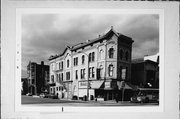Property Record
1001 N Doctor Martin Luther King Jr Dr (AKA 1001 N 3RD ST (NW CORNER OF 3RD & STATE))
Architecture and History Inventory
| Historic Name: | JOHN HINKEL BUILDING/SALOON |
|---|---|
| Other Name: | DONGES HATS, CAPS AND GLOVES |
| Contributing: | Yes |
| Reference Number: | 46658 |
| Location (Address): | 1001 N Doctor Martin Luther King Jr Dr (AKA 1001 N 3RD ST (NW CORNER OF 3RD & STATE)) |
|---|---|
| County: | Milwaukee |
| City: | Milwaukee |
| Township/Village: | |
| Unincorporated Community: | |
| Town: | |
| Range: | |
| Direction: | |
| Section: | |
| Quarter Section: | |
| Quarter/Quarter Section: |
| Year Built: | 1877 |
|---|---|
| Additions: | |
| Survey Date: | 1984 |
| Historic Use: | small retail building |
| Architectural Style: | Italianate |
| Structural System: | |
| Wall Material: | Brick |
| Architect: | |
| Other Buildings On Site: | |
| Demolished?: | No |
| Demolished Date: |
| National/State Register Listing Name: | Old World Third Street Historic District |
|---|---|
| National Register Listing Date: | 3/19/1987 |
| State Register Listing Date: | 1/1/1989 |
| National Register Multiple Property Name: |
| Additional Information: | A 'site file' exists for this property. It contains additional information such as correspondence, newspaper clippings, or historical information. It is a public record and may be viewed in person at the Wisconsin Historical Society, Division of Historic Preservation-Public History. From the 1850s through the 1920s, the commercial activities of Milwaukee's German community centered here on North Third Street, which linked Milwaukee's main thoroughfare, West Wisconsin (then Grand) Avenue, with the German neighborhood atop Brewers' Hill just to the north. The link grew stronger in the 1880s and 1890s, when North Third also became the route of the major streetcar line leading north from downtown. North Third Street proved a good place to do business, and many German-immigrant entrepreneurs set up shop here. They particularly prospered in the decades after the Civil War--as Milwaukee was evolving from an agricultural processing, trading, and wholesaling center into an industrial city, and immigration continued to swell the city's north-side German neighborhoods. As business boomed, merchants tore down their wood-frame stores and hired architects to design larger, costlier brick and masonry structures. Old World Third Street Historic District preserves nineteen of these. Despite alteration of many of the 1870s and 1880s storefronts, most upper stories retain their original architectural character. Taken together, they offer a block-long glimpse of Milwaukee's late-nineteenth-century commercial life, when the city's foremost German-ethnic merchants sold and plied their trades here. Greeting visitors to the district, the long, narrow John Hinkel Building is a High Victorian structure trimmed with extensive ornamental brickwork. The segmentally arched windows are capped with brick hood moldings, each punctuated with an incised keystone. Built in 1877, the Hinkel originally housed a popular saloon. It also contained a public meeting hall upstairs, which John Hinkel rented to various organizations. The historic address of this building was 281 Third Street. The website http://content.mpl.org/cdm/ref/collection/HstoricPho/id/380 shows the Hinkel Building at the corner. |
|---|---|
| Bibliographic References: | INSCRIPTION. Tax Program. Perrin - Milwaukee Landmarks, p. 60. 1881 History of Milwaukee, p. 1489. Also called Central Hall Restaurant. Buildings of Wisconsin manuscript. |
| Wisconsin Architecture and History Inventory, State Historic Preservation Office, Wisconsin Historical Society, Madison, Wisconsin |

